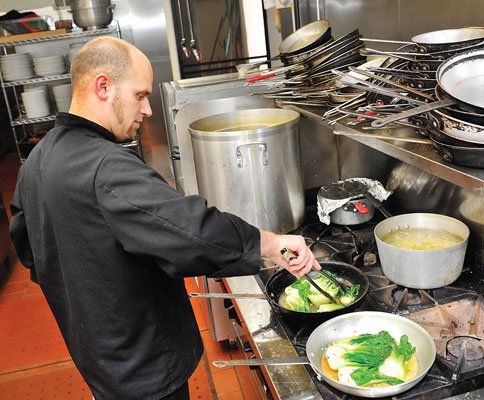On June 10, 1926, George Milias Sr. received a prescription for
whiskey
– which he promptly redeemed the same day at Johnson Drug store
on 7451 Monterey St.
On June 10, 1926, George Milias Sr. received a prescription for whiskey – which he promptly redeemed the same day at Johnson Drug store on 7451 Monterey St.
“He went straight down and filled it,” chuckled Adam Sanchez, staring at an enlarged photocopy of the script hanging on the wall inside the soon-to-be unveiled Milias Restaurant downtown.
“It was like medical marijuana,” joked his business partner, Ann Zyburra.
Prohibition or recession, there will always be a demand for good eats and good libations – “which is why we think it’s the perfect time to jump into the market,” says Zyburra.
As next week marks their soft opening, the proprietors of what use to be Harvest Time Restaurant at 7393 Monterey St. have restored Gilroy’s premiere hospitality destination to its former state of grandiose western glory – a new spark to help ignite the flames of downtown’s regenerating social scene.
Established by Yugoslavian immigrant George Milias Sr. in 1922, the Milias Hotel was the Garlic Capital’s social hot spot in its heyday. It boasted a “fine restaurant” and was a “favored place for travelers on Highway 101,” according to the City of Gilroy’s Historic Resources Inventory.
Like other longtime Gilroyans, Sanchez has childhood memories of eating at the Milias and recalls his father shuttling him there for a quick lunch every now and then.
“I’m very excited about it,” he said. “This place has always been Gilroy’s destination restaurant. The last couple people that had it really did it an injustice.”
From the old whiskey still, a spiky halo of 1800s barbed wire, cowhide chairs, authentic lighting fixtures from the original Milias Hotel, historic prints and an antique crank telephone, the restaurant’s aesthetic details pay homage to Gilroy’s rodeo roots and golden yesteryears when the likes of Clark Gable, John Wayne, Bing Crosby, Bob Hope, Tennessee Ernie Ford and Will Rogers sipped drinks at the 57-foot horseshoe bar.
“It’s going to be a real fun place to hang out. We brought a lot of history to this place. I have no nervousness to me,” said Sanchez.
The opening of the restaurant is the apex of an ongoing competition between himself and Zyburra, who once worked together at Sanchez’s fathers car dealership in Gilroy, and then again at a San Jose catering company. For years the friends joshed about opening a restaurant, but the wafting aroma of possibility was hard to resist when the space at Monterey Road and Sixth Street became available.
Sanchez signed a lease to take over the first-floor property Feb. 1, “and we haven’t left here since Feb. 2.”
Led by a classically trained executive chef who has worked at the Waldorf Astoria and opened the Ritz Carlton in Half Moon Bay, the duo sees their rejuvenated venue as an up-and-coming culinary contender to be reckoned with. They’re hoping to put a dent in the steady flow of patrons meandering to Morgan Hill in search of attractive dining ambiances, innovative cuisine and casual drinks.
“We’ve put our heart and soul into this,” Sanchez said. “People need a reason to stay in Gilroy and not travel.”
A foodie and self-taught chef, Sanchez won the 2001 Great Garlic Cook-Off with Garlic Marnier Duck Potstickers and made the finals in 2005 with “Gnock Out” Garlic Gnocchi.
He describes Milias fare as that of a true steakhouse, though six beef dishes are rivaled by 21 enticing appetizers and eclectic entrees: Chicken and Brie Saltimbocca, pesto-wrapped goat cheese with prosciutto and grilled ciabatta points, baked lasagna with Bechamel and bolognaise filling, a Coney Island foot-long hot dog, Hawaiian ahi tacos, warm cornbread with lavender-infused honey butter or pan seared boat scallops and wild caught shrimp with an apricot chardonnay sauce – options run the gamut from exotic, to classic, to comfort food.
“Our cuisine will match San Francisco, Napa – maybe above and beyond Carmel. We’re certainly going to raise the bar with the restaurant quality of food in town,” said Sanchez. “I’m very proud of what we can do and what we’re going to bring to the table in terms of quality of food and service.”
Painstaking oversight hasn’t been limited to the food, either. Sanchez and Zyburra have indulged the history variable, enlivening their rustic edifice with a cache intriguing artifacts representing local days of yore.
“Everything is falling into place like it was meant to be revived,” said Zyburra, pointing to the hand-laid mosaic tile underfoot.
An unexpected discovery during renovations, the original marble flooring was tediously unearthed from layers of carpet, linoleum, concrete and “a lot of nasty mastic,” or, sticky resin.
Iconic items including a film projector from Gilroy’s historic Strand Theater, a trio of ornate windows from the neighboring Hall building, an antique piano, movie theater benches from the Gaslighter Theater in San Jose, engraved dishes and a room key from the original Milias Hotel all accentuate the 1920s architecture with nostalgic flair.
As scenes from “The Bells of San Fernando” flickered on the wall near the bar, Sanchez explained silent black and white films will play continuously in the background – “moving art,” he coined it.
He’s also installed individual wine lockers for guests wishing to store choice bottles from personal collections brought from home, a fun luxury people are “clammering for already.”
One eye-catching nod to local heritage is a panel of 23 built-in frames, each bearing individual cattle brands burned onto wooden slats by members of the Santa Clara County Cattlemen’s Association.
Another remarkable artifact is an enlarged copy of a whiskey prescription administered to Milias during that failed “noble experiment” of the ’20s, a one-in-a-million find Sanchez obtained by chance from a private collector in New Jersey. It’s hanging on the wall next to a glass display case that reads “Anti Prohibition League.”
Indicating to two glass cases protecting hand-whittled brigades of horse-drawn covered wagons and figurines, Sanchez said this was a gift from an injured cowboy who was unable to pay his food or hotels bills.
After researching the creator’s name – Gene Hoback – Sanchez discovered this was a prolific sculptor in the ’40s whose work is catalogued by the Smithsonian American Art Museum.
As for the undulating cowboy mural above the bar, the establishment’s widely-recognized feature that’s been around for decades, this remains untouched.
Standing amid the empty dining room ready to be filled with customers, Zyburra acknowledged the risks of opening a new restaurant.
“But if we all listen to the doubters constantly, than no one would take the initiative to do anything. We’d just stay stuck. It’s time to step into things and try to bolster the economy.”














